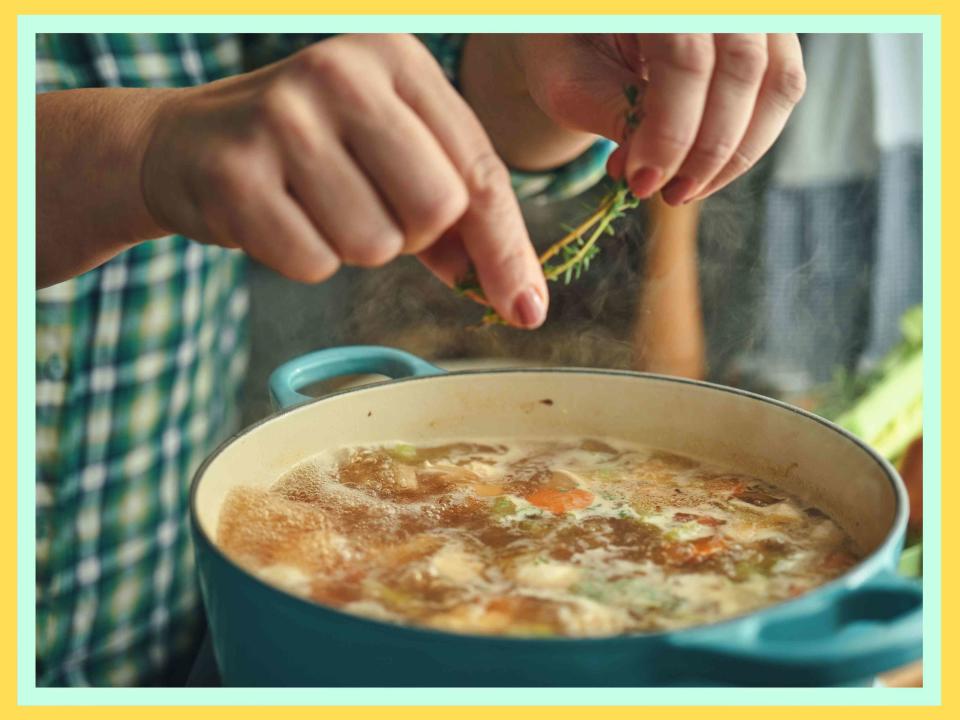My Family Makes Stock Together Once a Week—These Are the Kitchen Scraps We Always Save
Instead of tossing them, save them to make a flavorful broth.

Allrecipes/Getty Images
One of my family’s most cherished traditions is our weekly ritual of making stock. Not only does it serve as a foundational ingredient to dishes like congee or variations of Thai noodle soups, it’s also a great way to repurpose kitchen scraps from across the week. After all, making a great stock to us is about cutting down on waste all while using an array of leftover scraps to make a delicious base that's full of complex flavor.
How to Save Scraps for Stock
Making a great broth is easy—so easy, in fact, that you’ll never want to buy store-bought again. Whether it’s a vegetable- or a meat-based stock, simply collect leftover vegetable scraps (think: peels, skin, and cores) along with any remaining meat bones in a freezer-safe bag in the freezer. Then, when you’re ready to make stock, dump them into a pot full of water and simmer for a few hours until you’re left with a rich and flavorful stock.
Stock is so important in my family that we have an unofficial (but kind of official) rule to never throw out leftover vegetable parts, herbs, and other kitchen items and to instead save them for stock. If you haven’t already adopted this practice, then keep reading to make note of the items that you should always save to make next-level broths.
The Kitchen Scraps to Always Save for Stock

Vegetable Ends and Odds
One of the most integral parts of any good stock is an array of vegetables. While carrots, celery, and onion are well-known ingredients to an array of stocks—including chicken and vegetable broth—you can (and should be) saving leftover root vegetables like beets, ginger, turnips, radish, and yams to make a vegetable stock with plenty of flavor. This means saving scraps from prep and even leftover roasted vegetables for a well-rounded complex broth.
Herbs
In addition to vegetables, leftover herb cuttings are also excellent for stock. Just as they add a punch of fresh flavor to an array of dishes, it can do the same for your stock. In fact, when I was younger my dad taught me to always throw my cilantro stems into the freezer to add to stock for a peppery boost for my broths.
Other herbs like rosemary and parsley are great for stocks, but be weary of intense herbs like thyme or mint that can quickly overpower your broth rather than supplement it.
Parmesan Cheese Rind
So you’ve made your cacio e pepe and now you’ve got a leftover cheese rind. Don’t you dare toss it! In culinary terms it's worth its weight—or flavor—in gold. Parmesan rinds have such a deep flavor that when simmered down with vegetables turns into a rich stock—similar to chicken stock, but without the chicken.
When heated in a broth, all of the good flavors will melt into your stock without completely dissolving. Like the rest of your vegetables, strain before using your stock.
Tomato Paste
I’ve found that few recipes use up an entire can of tomato paste, and instead of putting it into a container (that I may or may not use up in time before it goes bad), I throw it in the freezer until I’m ready to make my next batch of stock. Doing so adds a nice sweet-salty-savory flavor to broths and stocks.
Items to Avoid Saving for Your Stock
While it may seem straight-forward enough to save all of your leftover vegetables to add to a stock, there is one vegetable group to be cautious of: cruciferous vegetables. While you absolutely can add cabbage, Brussels sprouts, and broccoli to stock, because they contain sulfur-based phytochemicals. When boiled down, they can make for an overall bitter taste and stock.
Read the original article on All Recipes.


